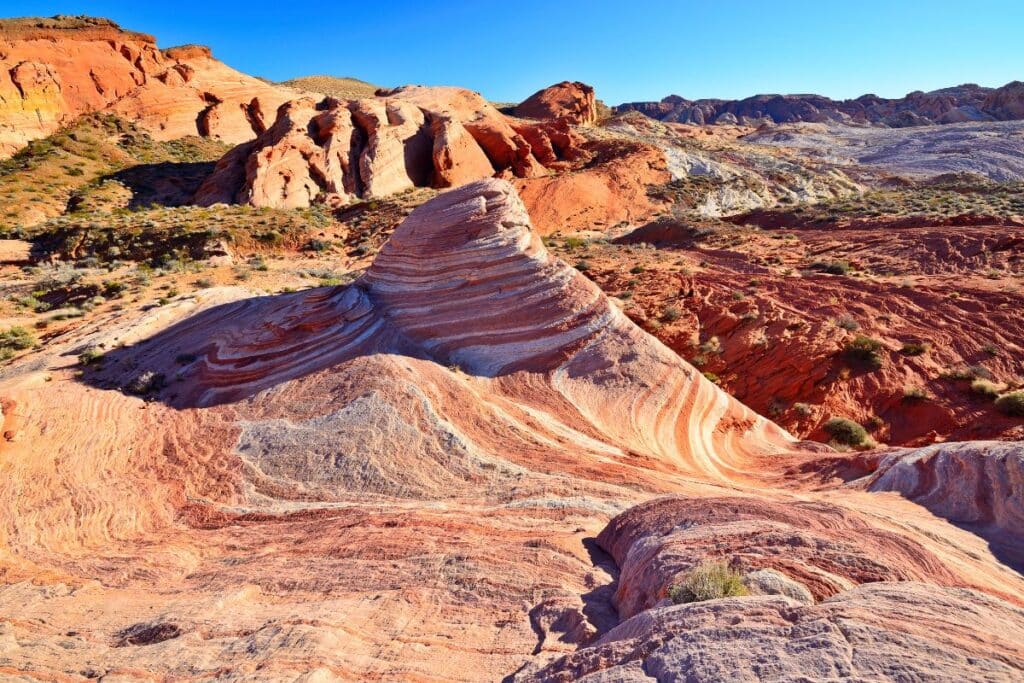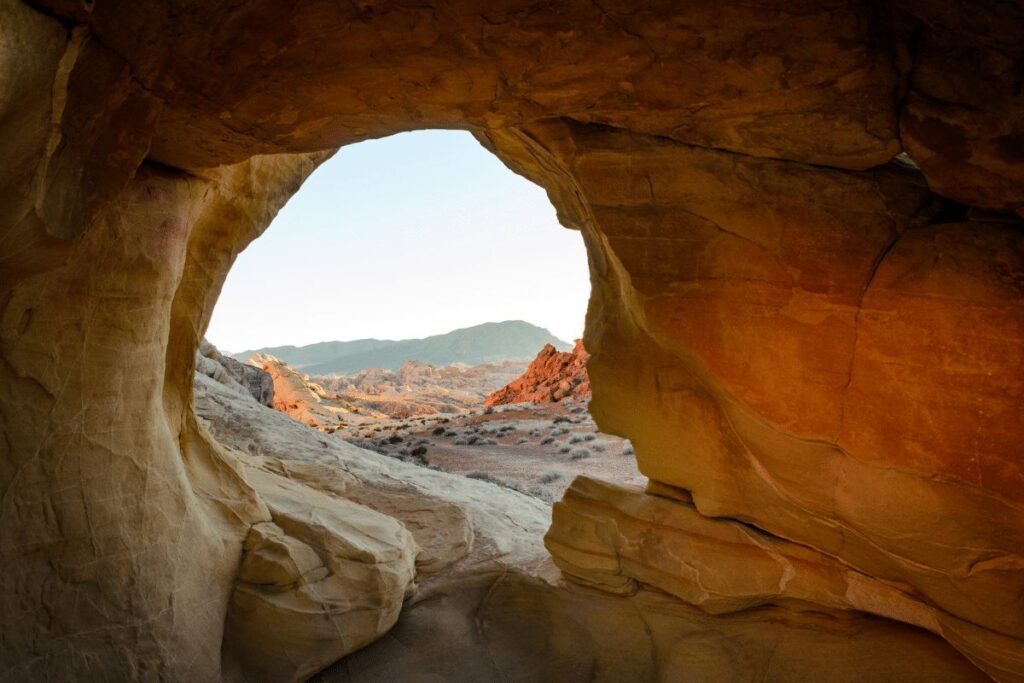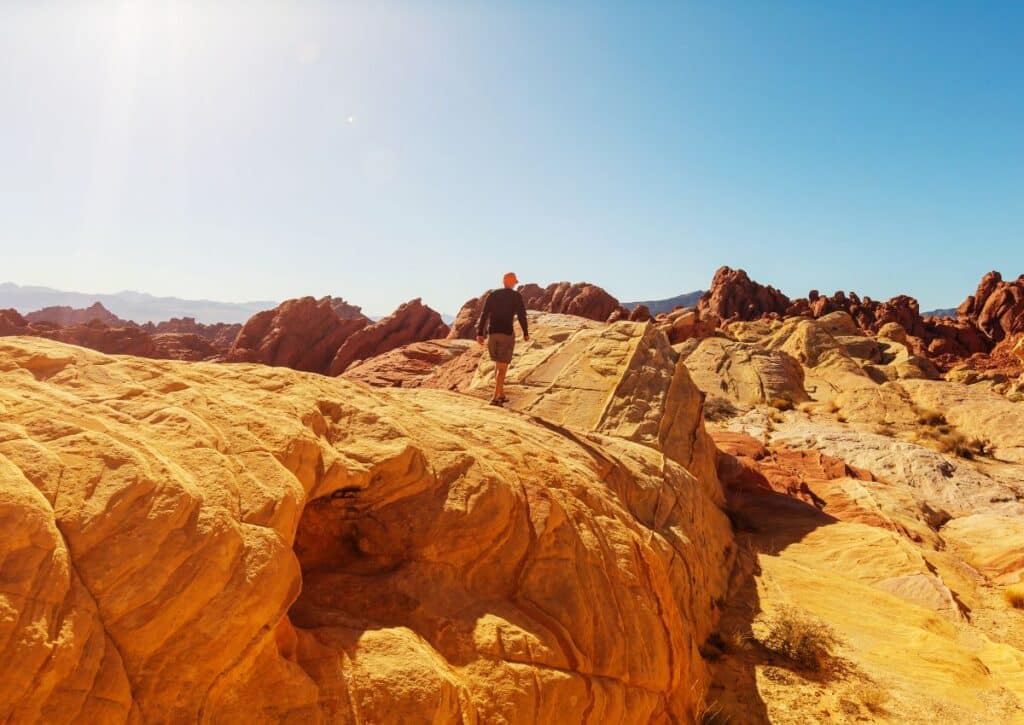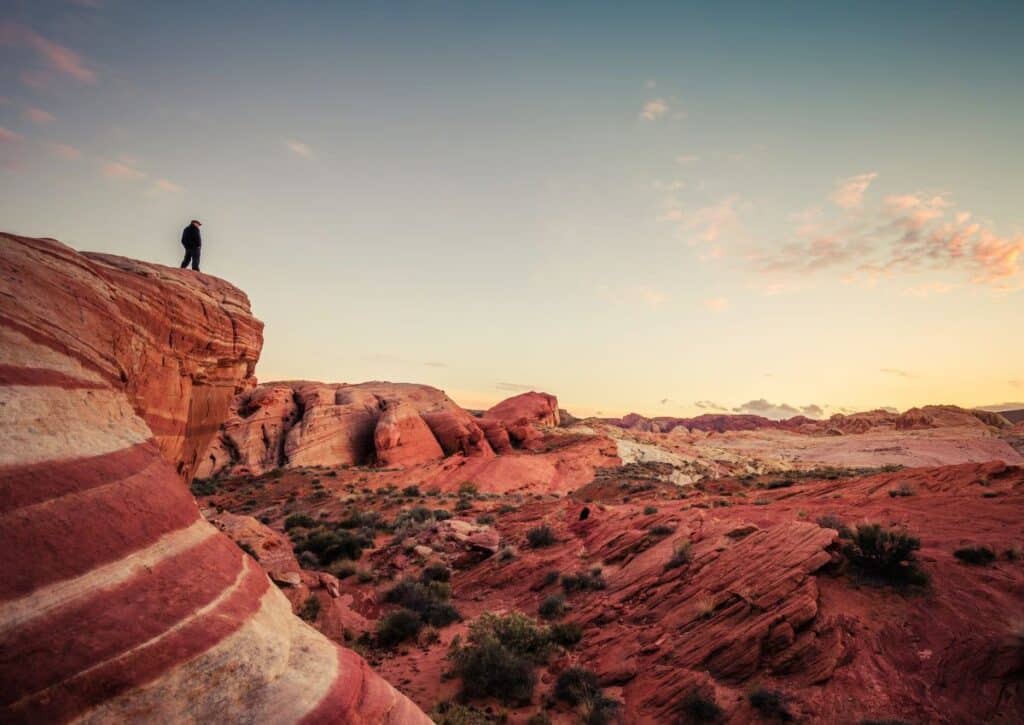Explore the Fire Wave in Valley of Fire State Park with our guide! Discover hiking tips, best times to visit, and stunning photography spots.
Imagine rippling waves of red and orange stone so surreal, you’ll swear you stepped onto Mars. Our hiking guide shares insider tips to discover Valley of Fire State Park’s magical Fire Wave Trail.
Glimpse billion-year-old sandstone swirls firsthand during this easy 1.5 mile trek.
Seasoned canyon rats and curious first-timers alike will find our guide useful, covering topics like best photography spots, ideal weather conditions and nearby adventures.
Follow our tips to make the most of your journey to the Fire Wave, an extraordinary flame-hued landmark defying gravity amid Nevada’s desert. Don’t just research this landscape anomaly – hike into its swirling heart yourself!
What Will You See at the Fire Wave in The Valley of Fire State Park?
The Fire Wave in Valley of Fire State Park is a dazzling highlight for any visitor. Picture waves frozen in time, but instead of water, they’re made of stone.
This is the magic of the Fire Wave, a canvas of swirling red, orange, and white hues, creating a visual spectacle that feels almost otherworldly.
The remarkable colors of the Fire Wave come from the sandstone’s natural mineral content, which has been painted by the hands of time into stripes and waves.
The patterns you see are the result of years upon years of natural sculpting by wind and rain, shaping the sandstone into the flowing forms we see today.
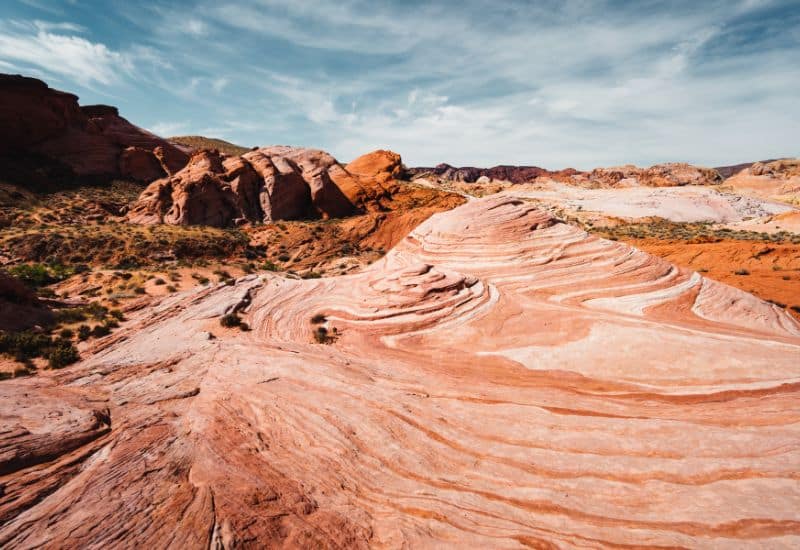
Walking through this area is like stepping into a living, breathing geological storybook. Once ancient sand dunes, these formations have been transformed into solid rock, capturing a moment in time that existed millions of years ago.
What makes the Fire Wave a must-visit isn’t just its beauty, but the experience of walking through a landscape that feels almost dream-like.
It’s a unique blend of nature’s artistry and the grandeur of geological history, all in one unforgettable hike.
The Fire Wave Hike
The Fire Wave Trail adventure begins at Parkplatz Fire Wave, situated at the end of Mouse’s Tank Road. This road, known for its scenic beauty, guides visitors through the heart of Valley of Fire State Park, connecting key attractions and trails, including the popular White Domes Trail.
As you start the hike, crossing to the west side of White Domes Road, the Fire Wave Trail immediately beckons. Heading northeast down a sandy slope, the path stretches before you, a 1.5-mile round trip journey that promises a modest elevation change of 230 feet.
Your path aims toward a long, steep ridge of red sandstone, a striking contrast to the landscape’s softer hues.
This area is unique for its vivid stripes, rare in nature, painting the landscape with interchanging streaks of beige and red-orange sandstone. It’s an arresting sight, reminiscent of an artist’s bold strokes on a grand canvas.
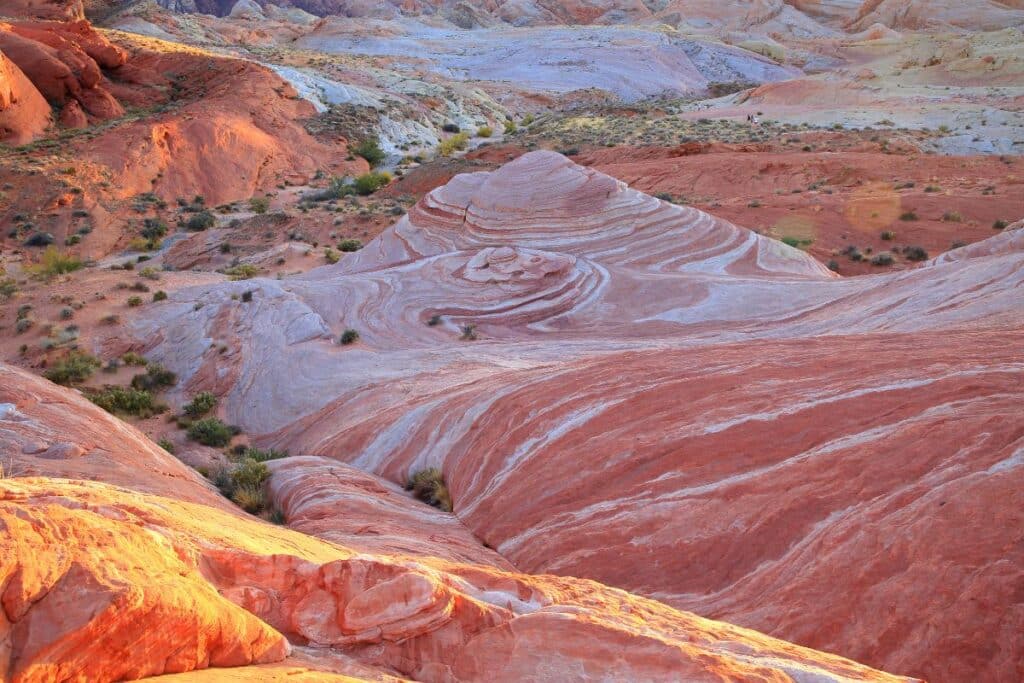
As the trail meanders, you approach a significant landmark, Gibraltar Rock. This imposing block of stone, part of a larger formation, leans out from the ridge, rising over 2,170 feet. Its presence is commanding, offering a unique backdrop for hikers and a testament to the park’s geological diversity.
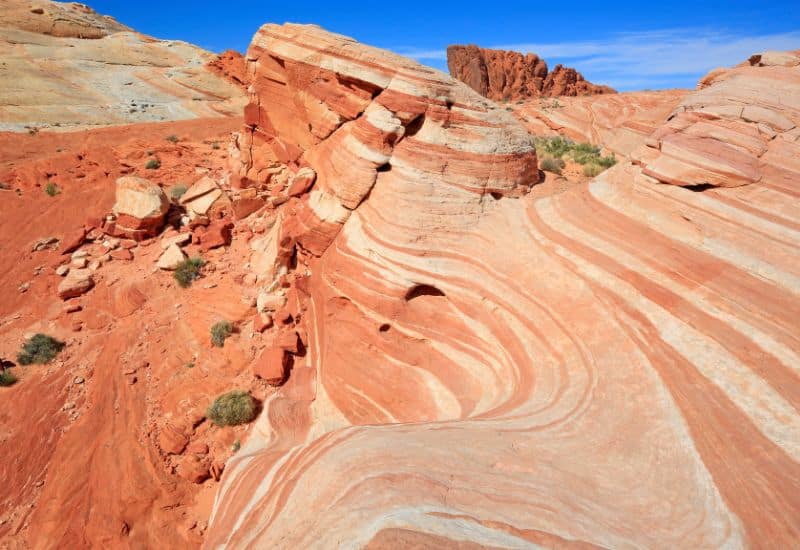
Navigating around Gibraltar Rock, the trail’s surface changes, from sandy to more packed terrain, easing your walk. Approximately 0.35 miles in, you encounter a slickrock formation running southeast, with lines that grow increasingly distinct as you progress. This is a prelude to the main spectacle, the Fire Wave itself.
The Fire Wave, emerging after half a mile of hiking, is a natural wonder. It’s a bowl-shaped depression adorned with wavy lines and rising points, creating an illusion of painted stripes.
This area, at the southwest end of the rock formation, is a highlight of the hike, offering a panoramic view that encapsulates the essence of the Valley of Fire.
The trail invites further exploration. Descending into the wave, the landscape reveals its full splendor, with orange and white stripes enveloping you.
To the west, the rock forms a dramatic scoop, showcasing some of the trail’s most intricate patterns. Climbing one of the rock islands, you are treated to a breathtaking view, a moment to absorb the serene beauty surrounding you.
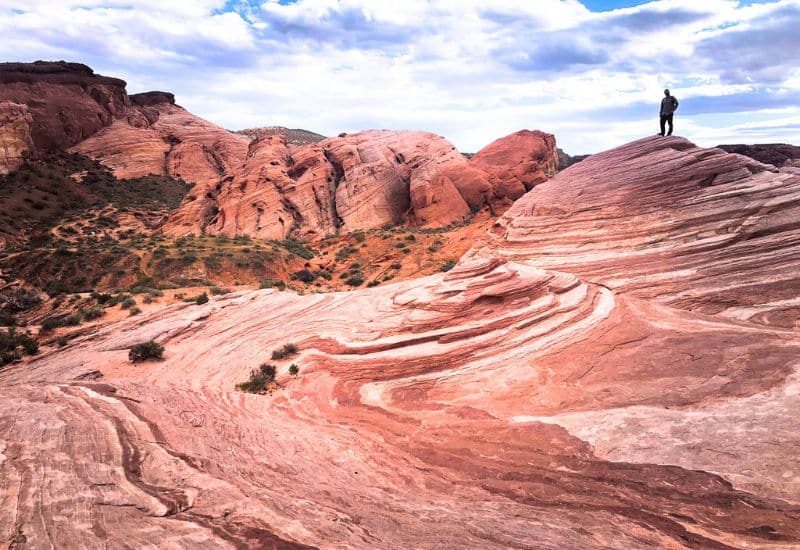
Beyond the Fire Wave, the trail leads to the south side, adjacent to Kaolin Wash. Here, the terrain shifts, presenting striped formations that continue the visual feast. Looking west, the White Domes Area looms, with earth tones of whites, pinks, and reds adding to the kaleidoscope of colors.
As the hike concludes, the return journey offers a fresh perspective. The overlapping stripes in the slickrock create an optical illusion, a final mesmerizing display of this unique landscape.
Before leaving, it’s important to remember that the Fire Wave Trail, open from sunrise to sunset, is a delicate ecosystem. Staying on the well-marked path is essential for preserving this natural wonder.
For those eager to share their experience, the trailhead provides good cell phone coverage, allowing for an immediate digital connection with friends and family.
Getting to the Fire Wave in Valley of Fire State Park
To experience the splendor of the Fire Wave, your journey begins with a trip to Valley of Fire State Park. Located just an hour’s drive from Las Vegas, the park is easily accessible by car.
Driving Directions:
- From Las Vegas, take Interstate 15 North for about 35 miles.
- Look for and take Exit 75, which is signposted for Valley of Fire State Park and Lake Mead National Recreation Area.
- Once off the exit, head southeast on Valley of Fire Highway for approximately 14.5 miles to reach the park’s west entrance.
- After entering the park, continue for another 3.5 miles.
- Turn left following the sign for the visitor center and Mouse’s Tank, but stay on White Domes Road as it veers left, bypassing the visitor center.
- Drive another 3.7 miles to Parking Lot #3, which is located on the left side across from the start of the Fire Wave Trail.
Public Transport and Tours:
- Public transportation to the park is limited, so if you’re not driving, consider booking a guided tour.
- Various tour operators in Las Vegas offer day trips to Valley of Fire State Park, which often include a visit to the Fire Wave along with other park highlights.
Remember, Valley of Fire State Park is a popular destination, especially during weekends and holidays. Arriving early can help you avoid crowds and secure parking at Parking Lot #3, the starting point for your adventure to the Fire Wave.
Best Times to Visit the Fire Wave
Visiting the Fire Wave in Valley of Fire State Park can be a breathtaking experience, and timing your visit right can make all the difference. The park experiences a range of seasonal variations that can affect your hike.
Seasonal Analysis:
- Spring (March to May) and Fall (September to November) are the ideal seasons to visit. During these months, the temperatures are mild, making hiking more comfortable. The park’s flora also comes to life in these seasons, adding to the scenic beauty.
- Summer (June to August) in the park can be extremely hot, often reaching temperatures above 100°F, which can make hiking challenging and less enjoyable.
- Winter (December to February) is cooler, but the temperatures are still pleasant for hiking. However, daylight hours are shorter.
Time of Day:
- Early morning or late afternoon are the best times for hiking to the Fire Wave. Not only are these times cooler, but the lighting is ideal for photography. The soft morning light enhances the rock colors, while the late afternoon sun casts dramatic shadows, making the formations come alive.
- Avoid midday hikes during summer when the sun is at its peak, as the heat can be intense and the light too harsh for good photos.
Recommendation: For the best overall experience, plan your hike to the Fire Wave in late March to early May or late September to early November. These months offer the perfect balance of pleasant weather, good lighting, and vibrant natural scenery, making your hike both enjoyable and memorable.
Photography Tips for Capturing the Fire Wave
The Fire Wave, with its unique colors and patterns, is a photographer’s dream. Here are some tips to help you capture its beauty:
1. Best Times for Photography:
- Golden Hour: Aim to be at the Fire Wave during the golden hours – shortly after sunrise or before sunset. The low angle of the sun enhances the red and orange hues of the rocks and creates long shadows, adding depth to your photos.
- Blue Hour: For a different mood, the blue hour, just before sunrise or after sunset, offers softer light and cooler tones, providing a unique perspective of the Fire Wave.
2. Recommended Equipment:
- Camera: A DSLR or a mirrorless camera will give you the best control over your settings, but even a smartphone can capture the beauty of the Fire Wave.
- Lenses: A wide-angle lens is ideal for capturing the vastness of the landscape. If you have a zoom lens, it can be useful for focusing on interesting patterns and textures.
- Tripod: A tripod is essential, especially for low-light conditions during sunrise or sunset, to prevent camera shake and ensure sharp images.
- Polarizing Filter: Consider using a polarizing filter to reduce glare and enhance the sky’s contrast against the colorful rocks.
3. Camera Settings:
- Aperture: Use a smaller aperture (higher f-number) to ensure a greater depth of field, keeping more of the scene in focus.
- ISO: Keep the ISO as low as possible to reduce noise, especially in bright conditions.
- Shutter Speed: Adjust according to the light. Use a slower shutter speed for low-light conditions, but ensure it’s fast enough to avoid blur if you’re not using a tripod.
4. Best Spots for Photography:
- On the Wave: Standing on the Fire Wave itself offers a great vantage point for capturing its patterns and the surrounding landscape.
- Elevated Views: Find a higher spot around the Fire Wave to get a panoramic view of the area.
- Close-Ups: Don’t forget to capture the intricate details of the sandstone patterns by focusing on smaller sections of the rock formation.
Remember, the key to great photography is often patience and experimentation. Take your time to explore different angles and settings to truly capture the essence of the Fire Wave.
Exploring Other Vistas in Valley of Fire State Park
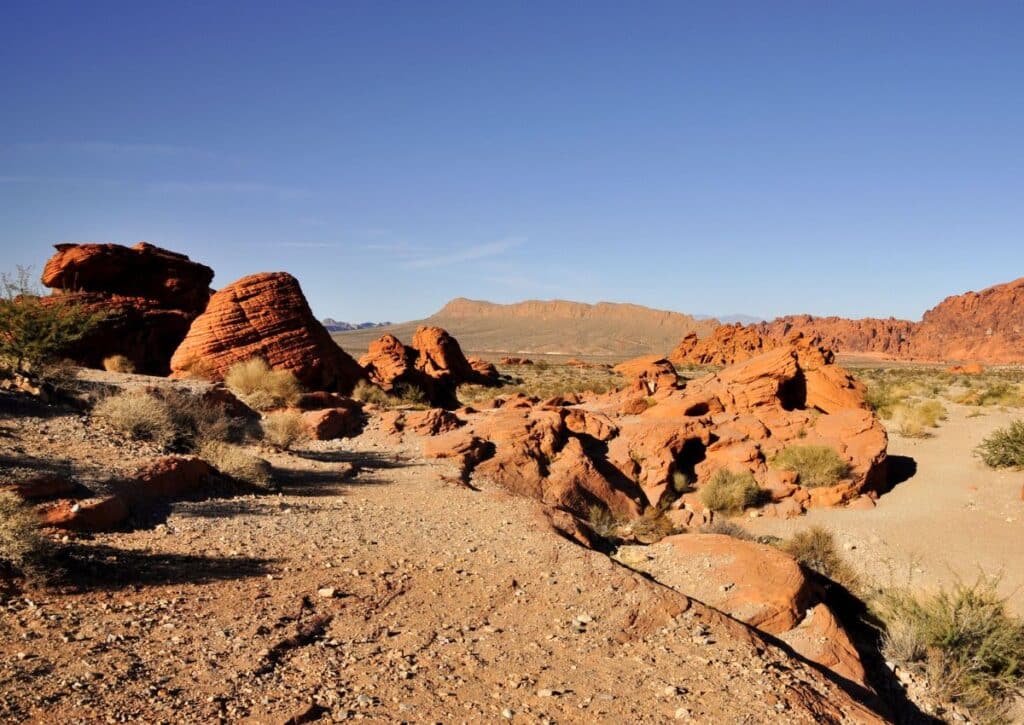
Apart from the Fire Wave, Valley of Fire State Park is home to a plethora of stunning vistas and formations. Here’s a brief overview of some must-visit spots:
- Mouse’s Tank: Named after a renegade Native American, Mouse’s Tank is a natural basin in the rock where water collects. The trail leading to it is lined with ancient petroglyphs and offers a glimpse into the history of the area.
- White Domes: This area is known for its dramatic, contrasting colors and diverse rock formations. The White Domes Trail is a short loop that takes you through stunning landscapes, including a slot canyon.
- Atlatl Rock: Famous for its remarkable ancient rock art, Atlatl Rock features petroglyphs that are believed to be thousands of years old. A set of metal stairs leads up to the rock art, making it easily accessible.
- Rainbow Vista: A viewpoint that offers a panoramic view of multi-colored sandstone formations. The area is especially popular for its photogenic landscape that shows the full spectrum of the park’s sandstone colors.
- The Beehives: Unique sandstone formations that resemble beehive shapes. Their unusual appearance is the result of wind and water erosion.
Each of these spots offers a unique experience and showcases the diverse beauty of Valley of Fire State Park. Whether you’re interested in history, photography, or simply enjoying nature, these vistas are sure to enhance your visit.
Also Read: 11 VALLEY OF FIRE STATE PARK VISTAS WE EXPLORED AN HOW!
Things to Do in Valley of Fire State Park

Valley of Fire State Park offers a range of activities for visitors:
- Hiking: The park features trails like the Fire Wave, White Domes, and Elephant Rock, offering diverse landscapes and geological wonders for all hiking levels.
- Photography: With its vibrant rock formations, the park is a haven for photographers, especially during the golden hours of sunrise and sunset.
- Wildlife Watching: The area is home to desert bighorn sheep, coyotes, and various bird species, making it ideal for wildlife enthusiasts.
- Camping: The park has camping facilities at Atlatl Rock and Arch Rock campgrounds, equipped with RV sites, restrooms, and water.
- Exploring Rock Art: Discover ancient petroglyphs at Atlatl Rock and Mouse’s Tank, offering a window into the region’s historical inhabitants.
- Stargazing: The minimal light pollution in the park makes it a perfect spot for stargazing on clear nights.
- Geology Tours: Join guided tours or explore independently to learn about the park’s unique geological formations and the natural forces that shaped them.
Valley of Fire State Park provides a variety of experiences, from outdoor adventures to educational opportunities, making it a diverse and enriching destination for all visitors.
Alos Read: 12 BEST THINGS TO DO IN THE VALLEY OF FIRE: OUR ULTIMATE BUCKET LIST!
Final Thoughts
The Fire Wave hike in Valley of Fire State Park encapsulates the essence of an ideal outdoor adventure. It’s a perfect blend of accessibility, natural beauty, and geological wonder, making it an excellent choice for hikers of all levels and interests.
Whether you’re a photography enthusiast, a nature lover, or just seeking a memorable hike, the Fire Wave offers an experience that’s both enriching and awe-inspiring.
This hike, with its unique patterns and vibrant colors, is not just a trek but a journey into the heart of one of Nevada’s most spectacular landscapes. For anyone looking to explore the wonders of the desert, the Fire Wave stands out as a must-visit destination.
What is the Fire Wave Hike?
The Fire Wave Hike is a popular trail in Nevada’s Valley of Fire State Park. It is known for its stunning sandstone formations, characterized by vibrant, wave-like patterns of red, orange, and white hues.
How long is the Fire Wave Hike?
The hike is a 1.5-mile round trip with an elevation change of approximately 230 feet. It is considered an easy to moderate hike.
Where is the Fire Wave located?
The Fire Wave is located in Valley of Fire State Park, about an hour’s drive northeast of Las Vegas, Nevada.
Do I need any special equipment for the hike?
Standard hiking gear is recommended, including sturdy footwear, water, sun protection, and a camera. A tripod can be useful for photographers, especially during sunrise or sunset.
Is the Fire Wave hike suitable for children?
Yes, the hike is family-friendly and suitable for children who can manage a short walk. The trail is not overly challenging, but supervision is necessary due to uneven terrain.
What is the best time of year to visit the Fire Wave?
The best times to visit are during the spring (March to May) and fall (September to November) when temperatures are more moderate.
Can I bring my pet on the Fire Wave hike?
Pets are allowed on the Fire Wave trail, but they must be kept on a leash at all times. It’s important to ensure pets are comfortable with the trail conditions and weather.
Is there an entrance fee for Valley of Fire State Park?
Yes, Valley of Fire State Park charges an entrance fee. The fee is typically per vehicle and is required for accessing the park, including the Fire Wave hike. As of my last update, the fee was $10 per vehicle for Nevada residents and $15 per vehicle for non-residents. However, these rates can change, so it’s recommended to verify the current fee on the park’s official website or inquire at the park’s entrance station upon arrival.
Is the trail well-marked?
Yes, the Fire Wave trail is well-marked with clear signage, making it easy to navigate for hikers.
What are some of the facilities available for the Fire Wave Trail?
For the Fire Wave Trail, there is a designated gravel parking area on the left side of the main road within Valley of Fire State Park. This parking area is situated approximately 4.7 miles from the Visitors Center and is clearly marked on the State Park brochure. However, it’s important to note that restroom facilities are not available at the trailhead itself. The nearest restrooms are located about 1 mile away, adjacent to the parking lot for the White Domes Trail. Visitors planning to hike the Fire Wave Trail should consider stopping at these facilities before starting their hike.

